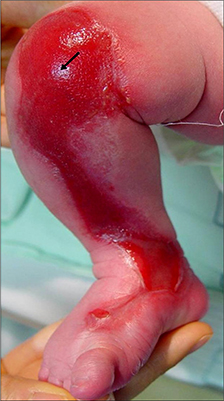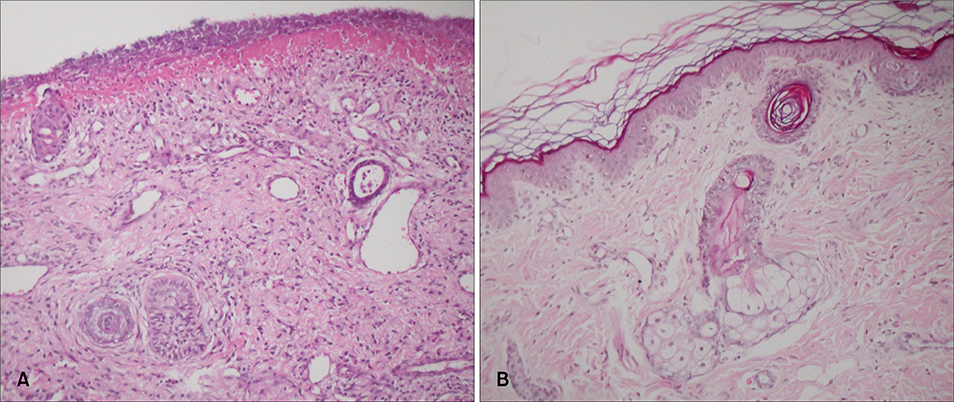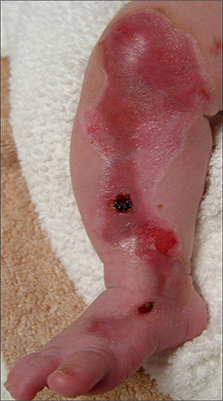Ann Dermatol.
2008 Jun;20(2):70-73. 10.5021/ad.2008.20.2.70.
A Case of Aplasia Cutis Congenita, Type VII
- Affiliations
-
- 1Department of Dermatology, Chonnam National University Medical School, Gwangju, Korea. schul@chonnam.ac.kr
- KMID: 2172087
- DOI: http://doi.org/10.5021/ad.2008.20.2.70
Abstract
- Aplasia cutis congenita (ACC) is a rare congenital defect in which localized or widespread areas of the skin are absent at birth. In the majority of cases, it is limited to the scalp especially on the vertex although other areas of the body may also be involved. Other congenital malformations can be associated with ACC. We present herein the case of a new born male with unilateral absence of skin on the extensor surface of the right lower leg. There was no associated malformation or skin disease such as blistering or nail abnormailty. According to the classification outlined by Frieden, the condition was diagnosed as type VII aplasia cutis congenita. The treatment of this large ulcer was conservative, wet dressing and prophylactic topical antibiotics. On follow up after 2 years showed that the patient was nearly cured of the ulcer and had only minimal scar formation.
Keyword
MeSH Terms
Figure
Reference
-
1. Corden M. Extrait d'une letter au sujet de trios enfants de la meme nes avee partie des extremities denuee de peau. J Med Chir Pharmacie. 1767; 26:556–557. Cited from reference 2.2. Frieden IJ. Aplasia cutis congenital: a clinical review and proposal of classification. J Am Acad Dermatol. 1986; 14:646–660.
Article3. Sybert VP. Aplasia cutis congenita: a report of 12 new families and review of the literature. Pediatr Dermatol. 1985; 3:1–14.
Article4. Kelly BJ, Samolitis NJ, Xie DL, Skidmore RA. Aplasia cutis congenita of the trunk with fetus papyraceus. Pediatr Dermatol. 2002; 19:326–329.
Article5. Mannino FL, Jones KL. Benirschke: Congenital skin defects in fetus papyraceus. J Pediatr. 1997; 4:559–564.6. Fusi L, McParland P, Fisk N, Nicolini U, Wigglesworth J. Acute twin-twin transfusion: A possible mechanism for brain-damaged survivors after intrauterine death of a monochronic twin. Obstet Gynecol. 1991; 78:517–520.7. Torpin R. Amniochronic mesoblastic fibrous strings and amniotic bands. Am J Obstet Gynecol. 1965; 91:65–75.8. Light TR, Ogden JA. congenital constriction band syndrome. Pathophysiology and treatment. Yale J Biol Med. 1993; 66:143–155.9. Weedon D. Skin pathology. 1st ed. New York: Churchill-Livingstone;1997.10. Bridges AG, Mutasim DF. Pretibial dystrophic epidermolysis bullosa. Cutis. 1999; 63:329–332.11. Mempel M, Abeck D, Lange I, Stom K, Calibe A, Beham A, et al. The wide spectrum of clinical expression in Adams-Oliver syndrome; a report of two cases. Br J Dermatol. 1999; 104:1157–1160.
Article12. Gutzmer R, Herbst RA, Becker J. Bart syndromeseparate entity or a variant of epidermolysis bullosa? Hautarzt. 1997; 48:640–644.13. Gharpuray MB, Tolat SN, Patki AH. Congenital localized absence of skin associated with blistering of the skin and mucous membrane; Bart's syndrome. Cutis. 1989; 44:318–320.14. Park SH. A case of aplasia cutis congenita. Korean J Dermatol. 1984; 22:346–349.15. Choi HM, Myung KB, Kook HI. Two cases of aplasia cutis congenita. Korean J Dermatol. 1985; 23:83–87.16. Chung J, Lee WS, Ahn SK. Aplasia cutis congenita. Korean J Dermatol. 1994; 32:698–702.17. Park JM, Kim YS, Kwon SJ, Yu HJ, Park YW. A case of aplasia cutis congenita. Korean J Dermatol. 2000; 38:295–297.18. Mo HJ, Park CJ, Yi JY. A case of aplasia cutis congenita. Korean J Dermatol. 2001; 39:612–614.19. Park G, Kim HJ, Jang HC, Chung H. A case of aplasia cutis congenita after methimazole exposure during pregnancy. Korean J Dermatol. 2006; 44:642–644.




